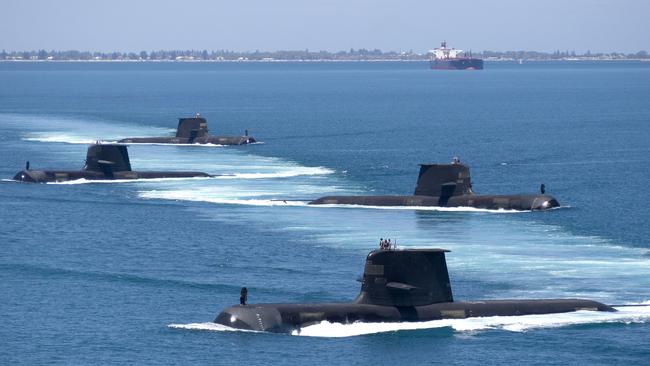Collins upgrade may plug submarine gap
A Peter Dutton intervention will ensure Australia is not left exposed by the late arrival of new French-built submarines.

Peter Dutton is planning an intervention to ensure Australia is not left exposed by the late arrival of new French-built submarines, with fast-tracked and comprehensive rebuilds of the navy’s six Collins-class boats now seen as vital.
The Defence Minister is preparing to use the Collins Life of Type Extension program to avoid a capability gap, as former minister Brendan Nelson did when he ordered the purchase of a squadron of Super Hornets to hedge against the late arrival of the F-35 fighters.
Mr Dutton, who regards the French submarine program as “a mess”, is considering a proposal to engage the original Collins builders, Saab Kockums, to work as strategic partners with the government-owned ASC (formerly Australian Submarine Corporation) to overhaul the 1990s-era boats.
Amid ongoing difficulties with French submarine company Naval Group, Mr Dutton is also looking at an option to engage Saab Kockums to develop a $50m-$100m design scoping study for a “Son of Collins” boat, based on a submarine the company is offering the Dutch navy.
The risk mitigation strategy would introduce a late rival to Naval Group’s yet to be designed Attack-class sub, signalling the government has another option if the company does not meet its budget, timeline or local content requirements.
The options are among those being examined by an internal navy inquiry headed by Vice Admiral Jonathan Mead, who has warned the government that worsening strategic circumstances mean the Attack-class boats — the first of which is not due to enter service until 2034 — will arrive too late to deter a potential conflict in Australia’s immediate region.
Defence officials told Senate estimates last October that the Collins-class LOTE program was estimated to cost between $3.5bn and $6bn.
But senior defence sources confirmed some estimates now put the cost at up to $9bn, or $1.5bn a boat, to ensure they remain “regionally superior” for another decade or more.
The Collins rebuilds now under consideration would go further than the “obsolescence management” approach initially proposed by Defence, installing new diesel generators, main motors, switching gear, batteries, sensors and digital periscopes.
Admiral Mead is examining the feasibility of commencing the LOTE program two years ahead of schedule, in 2024, delivering four virtually new boats by 2032 when the first Attack-class sub is scheduled to enter sea trials.
He has advised the government that a significant investment is urgently needed to deliver a near-term capability boost, following the 2020 Defence Strategic Update warning that Australia no longer has a decade to prepare for a major conflict.
The government is acutely aware that first-of-class shipbuilding programs are inevitably late and over-budget, making the case for comprehensive Collins’ rebuilds even more compelling.
Senior Defence sources said Mr Dutton was working through the options methodically, but the minister believed hard decisions were now required.
They said the government was losing patience with Naval Group, rejecting two separate contractual offers from the company on its next stage of its work.
The commencement of the detailed design of the Attack-class subs has now been pushed back until September.
Defence is awaiting a final Collins LOTE funding decision from the government by June.
Retired Rear Admiral Peter Clarke, a former Royal Navy commander of both conventional and nuclear submarines, said extensive Collins-class upgrades were the only way to ensure the nation maintained a submarine deterrent before the Attack-class boats arrived.
“There are no other options,” Admiral Clarke said, urging the government to come to a swift decision on the plan.
“A lot of these things come about because people don’t make decisions early enough. There are highly complex programs with a lot of unknowns. You need to give yourself a lot of fat in the timescale.”
Saab Kockums recently completed midlife upgrades to Sweden’s Gotland-class submarines, on which the Collins were originally based which included the installation of new combat systems and digital periscopes.
The option for a Son of Collins instead of the Attack-class boats is seen by many in the defence sector as an extreme one. But one source likened it to having multiple COVID vaccine options.
Australian Strategic Policy Institute director Peter Jennings said the Collins LOTE program had for years been seen by Defence as the “poor cousin” to the Attack-class program, but it was now clear Australia would have to upgrade their “capability and lethality” beyond just keeping them operational.
“It was inevitable really that the Collins was going to have to stay in the water for another decade and a half, or longer,” Mr Jennings said.








To join the conversation, please log in. Don't have an account? Register
Join the conversation, you are commenting as Logout